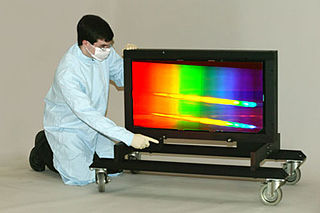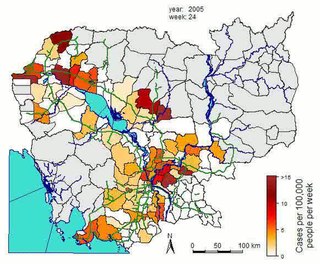Related Research Articles

In optics, a diffraction grating is an optical component with a periodic structure that diffracts light into several beams travelling in different directions. The emerging coloration is a form of structural coloration. The directions or diffraction angles of these beams depend on the wave (light) incident angle to the diffraction grating, the spacing or distance between adjacent diffracting elements on the grating, and the wavelength of the incident light. The grating acts as a dispersive element. Because of this, diffraction gratings are commonly used in monochromators and spectrometers, but other applications are also possible such as optical encoders for high precision motion control and wavefront measurement.
A pangram or holoalphabetic sentence is a sentence using every letter of a given alphabet at least once. Pangrams have been used to display typefaces, test equipment, and develop skills in handwriting, calligraphy, and keyboarding.
In cryptography, coincidence counting is the technique of putting two texts side-by-side and counting the number of times that identical letters appear in the same position in both texts. This count, either as a ratio of the total or normalized by dividing by the expected count for a random source model, is known as the index of coincidence, or IC for short.

In cryptanalysis, frequency analysis is the study of the frequency of letters or groups of letters in a ciphertext. The method is used as an aid to breaking classical ciphers.

In epidemiology, incidence is a measure of the probability of occurrence of a given medical condition in a population within a specified period of time. Although sometimes loosely expressed simply as the number of new cases during some time period, it is better expressed as a proportion or a rate with a denominator.

Charles Lincoln Van Doren was an American writer and editor who was involved in a television quiz show scandal in the 1950s. In 1959 he testified before the U.S. Congress that he had been given the correct answers by the producers of the NBC quiz show Twenty-One. Terminated by NBC, he joined Encyclopædia Britannica, Inc. in 1959, becoming a vice-president and writing and editing many books before retiring in 1982.

The Polish alphabet is the script of the Polish language, the basis for the Polish system of orthography. It is based on the Latin alphabet but includes certain letters with diacritics: the acute accent ; the overdot ; the tail or ogonek ; and the stroke. ⟨q⟩, ⟨v⟩, and ⟨x⟩, which are used only in foreign words, are usually absent from the Polish alphabet. However, prior to the standardization of the Polish language, ⟨x⟩ was sometimes used in place of ⟨ks⟩.
An autogram is a sentence that describes itself in the sense of providing an inventory of its own characters. They were invented by Lee Sallows, who also coined the word autogram. An essential feature is the use of full cardinal number names such as "one", "two", etc., in recording character counts. Autograms are also called 'self-enumerating' or 'self-documenting' sentences. Often, letter counts only are recorded while punctuation signs are ignored, as in this example:
This sentence employs two a's, two c's, two d's, twenty-eight e's, five f's, three g's, eight h's, eleven i's, three l's, two m's, thirteen n's, nine o's, two p's, five r's, twenty-five s's, twenty-three t's, six v's, ten w's, two x's, five y's, and one z.
Gimel is the third letter of the Semitic abjads, including Phoenician Gīml , Hebrew Gimel ג, Aramaic Gāmal , Syriac Gāmal ܓ, and Arabic ǧīm ج. Its sound value in the original Phoenician and in all derived alphabets, except Arabic, is a voiced velar plosive ; in Modern Standard Arabic, it represents either a or for most Arabic speakers except in Northern Egypt, the southern parts of Yemen and some parts of Oman where it is pronounced as the voiced velar plosive.
Greek letters are used in mathematics, science, engineering, and other areas where mathematical notation is used as symbols for constants, special functions, and also conventionally for variables representing certain quantities. In these contexts, the capital letters and the small letters represent distinct and unrelated entities. Those Greek letters which have the same form as Latin letters are rarely used: capital A, B, E, Z, H, I, K, M, N, O, P, T, Y, X. Small ι, ο and υ are also rarely used, since they closely resemble the Latin letters i, o and u. Sometimes, font variants of Greek letters are used as distinct symbols in mathematics, in particular for ε/ϵ and π/ϖ. The archaic letter digamma (Ϝ/ϝ/ϛ) is sometimes used.
The diehard tests are a battery of statistical tests for measuring the quality of a random number generator. They were developed by George Marsaglia over several years and first published in 1995 on a CD-ROM of random numbers.
In cryptography, the clock was a method devised by Polish mathematician-cryptologist Jerzy Różycki, at the Polish General Staff's Cipher Bureau, to facilitate decrypting German Enigma ciphers. The method determined the rightmost rotor in the German Enigma by exploiting the different turnover positions. For the Poles, learning the rightmost rotor reduced the rotor-order search space by a factor of 3. The British improved the method, and it allowed them to use their limited number of bombes more effectively.
The pound was one of several issues of Japanese invasion money used during World War II. One pound was subdivided into 20 shillings. Consisting of only four denominations, the Oceanian pound was the shortest set issued. Only notes for £1, 10/–, 1/– and 1/2/– were issued.

Cube Route is a fantasy novel by British-American writer Piers Anthony, the twenty-seventh book of the Xanth series.
In statistics, the frequency of an event is the number of times the observation has occurred/recorded in an experiment or study. These frequencies are often depicted graphically or in tabular form.
Letter frequency is the number of times letters of the alphabet appear on average in written language. Letter frequency analysis dates back to the Arab mathematician Al-Kindi (c. 801–873 AD), who formally developed the method to break ciphers. Letter frequency analysis gained importance in Europe with the development of movable type in 1450 AD, where one must estimate the amount of type required for each letterform. Linguists use letter frequency analysis as a rudimentary technique for language identification, where it is particularly effective as an indication of whether an unknown writing system is alphabetic, syllabic, or ideographic.
Tile tracking is a technique most commonly associated with the game of Scrabble and similar word games. It refers to the practice of keeping track of letters played on the game board, typically by crossing letters off a score sheet or tracking grid as the tiles are played. Tracking tiles can be an important aid to strategy, especially during the endgame when there are no tiles left to draw, where careful tracking allows each player to deduce the remaining unseen letters on the opponent's final rack. The marking off of each letter from a pre-printed tracking grid as the tiles are played is a standard feature of tournament play.
In statistics, additive smoothing, also called Laplace smoothing or Lidstone smoothing, is a technique used to smooth categorical data. Given a set of observation counts from a -dimensional multinomial distribution with trials, a "smoothed" version of the counts gives the estimator:

The articles in English are the definite article the and the indefinite articles a and an. They are the two most common determiners. The definite article is the default determiner when the speaker believes that the listener knows the identity of a common noun's referent. The indefinite article is the default determiner for other singular, countable, common nouns, while no determiner is the default for other common nouns. Other determiners are used to add semantic information such as amount, proximity, or possession.
A panalphabetic window is a stretch of text that contains all the letters of the alphabet in order. It is a special type of pangram or pangrammatic window.
References
- ↑ Malcolm Rowe, "Pangrams on the Web", .
- ↑ Sean A. Irvine, "A 42-letter Pangrammatic Window" in Word Ways , 45, 313--316, 2012.
- ↑ "Sub-60-Letter Pangrammatic Windows" in the February 2006 edition of Word Ways: The Journal of Recreational Linguistics